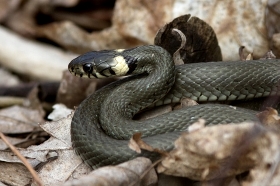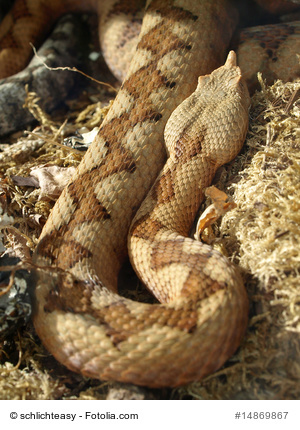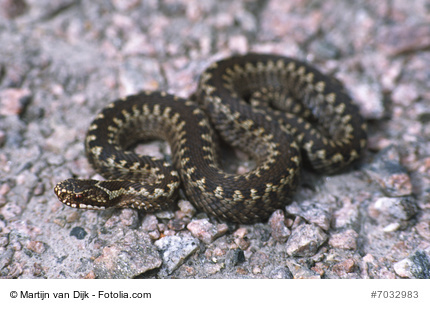Snakes Greece: All species on the mainland and islands
Nowhere in Europe are there as many species of snakes as in Greece. The warm, dry summer climate is ideal for many reptiles. Some of the snakes in Greece are poisonous and some are quite dangerous to humans. Since we know that readers of this website want to find out more about the poisonous snakes in Greece, the poisonous snake species are the focus of the information below.
In Greece, dangerous poisonous snakes are found on the mainland and on many, but not all, islands. It is extremely difficult to get reliable information about which snakes are found in which regions and islands. Many literature sources and statements from locals are contradictory. Therefore, not all of the information on this page is necessarily correct. The distribution area of the snake species can also extend to more regions and islands than those listed below.

Most snake species are rather shy. I have only seen a snake a few times in several years in Greece. I don’t know anyone in my circle of friends who has ever been bitten by a snake in Greece. Nevertheless, snake bites do occur. In Greece, you should always see a doctor or hospital as soon as possible after a snake bite. Even bites from non-venomous snake species can sometimes lead to infections at the bite site. People often react very differently to snake venom.
The viper is the classic poisonous snake in Europe and Asia. Almost all poisonous snakes in Greece are vipers. There are at least five species of viper.
|
Horned viper: This snake is probably the most venomous and dangerous species of snake in Greece and possibly in all of Europe. Horned vipers are found in Greece primarily on the mainland (in many regions also in Athens and other cities such as Thessaloniki). The viper is also not uncommon in the Peloponnese. People can die from a bite from this venomous snake. Children, the sick and the elderly are particularly at risk. Horned vipers have a noticeable horn on the front of their head (see picture). Unfortunately, we have not been able to conclusively determine whether horned vipers also occur on some Greek islands. They are also widespread throughout the Balkans, among other places. The reptile is also called horned viper, sand viper and sand adder. They often live in dry, rocky areas, also in holes in walls, between rocks and the like. In winter they often hibernate in large groups. Horned vipers are rather shy and prefer to flee rather than attack if possible. However, bites to humans do sometimes occur in Greece. There is an antiserum (antidote). |
 |
Cycladic viper: This very poisonous snake is found, as the name suggests, in the Cyclades. As far as we know, it is mainly found in the western regions of the island group. Most reports of the Cycladic viper come from Milos. This is why the snake is sometimes called the Milos viper. But the animals are also definitely found on Sifnos and Kimilos. They grow to a maximum length of about one meter and are of various colors. This species of viper is now also quite rare on the above-mentioned islands. There is also a literature source that speaks of frequent occurrences on Milos, for example.
We have no reports of Cycladic vipers on the large holiday islands in the region such as Santorini, Mykonos, Naxos, Amorgos or Paros. But we cannot rule this out either. Unfortunately, we were unable to find out whether the poisonous snake species lives on other western Cyclades such as Serifos, Kithnos, Folegandros or Sikinos.
The English name is “Macrovipera schweizeri” (after Hans Schweizer, who studied these animals for a long time). The Greeks call the Cycladic viper “Ochia tis Milos”. In the Natural History Museum in Heraklion (Crete) you can see live Cycladic vipers.
Our Tip
Hotels in Greece are best booked via Booking.com: wide selection from guesthouses to resorts, real guest reviews, flexible (often free) cancellation, and fair prices.
Mountain viper: These poisonous snakes are found in Greece, mainly on the eastern islands and in some smaller parts of northeastern Greece. Snake bites of this type are rare and usually not fatal. Nevertheless, you should always seek medical attention immediately. Some well-known holiday islands with these snakes are Kos, Kalymnos, Patmos, Leros, Samos and Chios. These poisonous snakes are often light brown or light gray with darker spots.
Mountain adders often live, but not only, at higher altitudes, usually in areas with little vegetation (soil such as stone or sand). Various species of them are also found in Turkey and the Middle East. We were unable to determine whether the poisonous snakes occur on the holiday islands of Lesbos, Thassos, Samos, Limnos or Rhodes. Information about snakes in Greece is difficult to obtain. There are reports of mountain adders on the following other islands: Leros, Lipsi, Symi and Samothraki. The poisonous mountain adder snake can also be found on other inhabited and uninhabited islands.
Adder: This poisonous snake is also found in Germany. It is very rare in Greece and, according to most literary sources, lives at most in the mountains in the north of the country. However, two locals told me about adders in the west of Crete (in the region around Kastelli-Kissamos). Unfortunately, we were unable to clarify whether this is true. We have not found any scientific reports about adders on Crete.
➔ To book ferries within Greece, we recommend the reputable website Ferryscanner.com

Meadow viper: This species is very rare and only occurs in very small numbers in the mountains of northern Greece. The amount of poison is rather small. The animals are small, and their diet consists of insects, among other things.
➔ Book hotels in Greece for 2025 now at a reasonable price
Boas in Greece
Even boas occur in one species in Greece! It is the western sand boa. Boas are among the giant snakes, but this species in Greece is rather small. They grow to around 60 to 80 centimeters long. The small constrictor snakes eat mice and larger insects, for example. Boas can also be found on many islands, e.g. on Corfu. Most boa species are non-venomous, including this species according to our information. A few species have poison in their saliva.
Tip: Hotels in Greece should be booked online. Prices are usually much cheaper and easier to compare. The best place to book is Booking.com.
Snakes in Greece
Snakes are generally not particularly dangerous to humans. Almost all species are non-venomous. A few snakes have venomous fangs in the back of their mouths, but they almost never use them when attacking. Some snakes are quite aggressive and can bite people several times in a row. The wounds can become infected.
Cat snake: This is one of the snakes that has venomous fangs in the back of its mouth. It is found in many areas in Greece, including Crete. The name has nothing to do with its appearance. Rather, the snake sneaks up slowly like a cat. Its prey is usually mice.
Leopard snake: A beautiful species of snake with a striking red pattern. I have come across leopard snakes several times in Crete. They often lie on the streets on cold, sunny days to warm themselves in the sun. The distribution area extends across the mainland and many islands.
Dice snake: This non-venomous snake is common in Greece. The reptile can also be found in Germany, but it is extremely rare here. They are large, mostly brown animals. The snake is native to Crete, Rhodes, and many other Greek islands.
Wrath snake: Aggressive, non-venomous snake that is widespread. It lives on the Greek mainland, but also on the islands of Crete, Zakynthos, Karpathos, and Corfu, among others. It is up to 160 cm long, often brown with dark spots. Wrath snakes bite quickly. People are also attacked if the snakes feel threatened. The bite wounds can be deep and bleed heavily. Wrath snakes can also be found throughout the Balkans, such as in Albania, Croatia, and Slovenia (see Snakes in the Balkans). They also occur in Cyprus. They live, for example, in wine-growing regions and near olive trees.
Pygmy snake: Small (around 50 cm) long, non-venomous snake. In Greece, for example, on Samos, Chios, Lesbos, Leros and Kalymnos. On the mainland, the snake lives in Turkey, for example, but not in Greece.
Spring snake: Very long reptile (up to 2 meters). Area: Entire mainland and many large islands except southern ones like Crete. Probably the longest snake in Greece. There are two species: the common Balkan spring snake and the smooth snake, which is rare in Greece.
Grass snake: These animals are found in almost all of Europe, and are often found in both Greece and Central Europe.
Poisonous snakes are by no means the only source of danger when hiking in Greece. We have often read reports in the Greek media of tourists who take too little water with them and die of thirst, fall in the mountains or are killed by rocks. The heat and the risk of heat stroke should also not be underestimated. At higher altitudes, it can get very cold in Greece, even in summer. Sudden changes in the weather, including thunderstorms and extremely strong winds, are not uncommon in many regions. There is also the risk of getting lost. Greece is very sparsely populated in parts and help is often far away. Cell phones do not work everywhere. Other poisonous animals include scorpions. Brown bears are also native to mainland Greece.
➔ Book cheap hotels in Greece for 2025
Do you have feedback, an addition, found an error or a comment? Send us an email to: mail@griechenland-insel.de